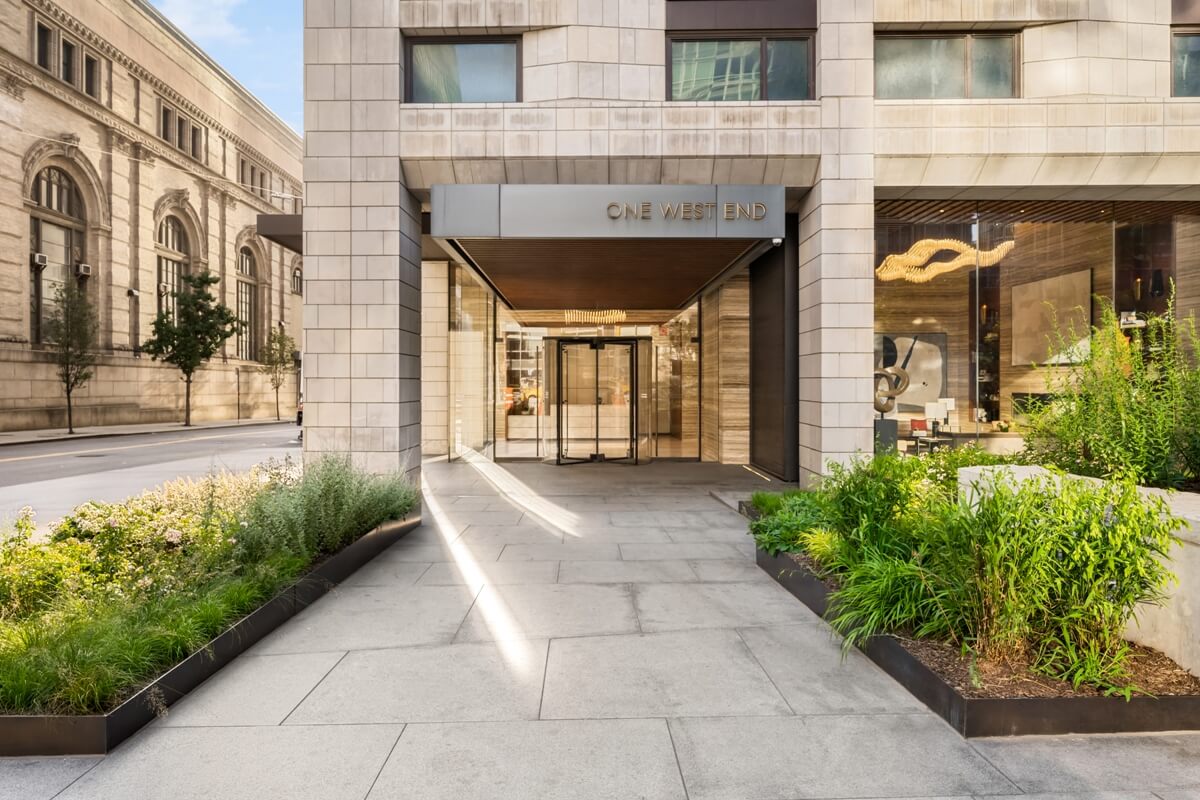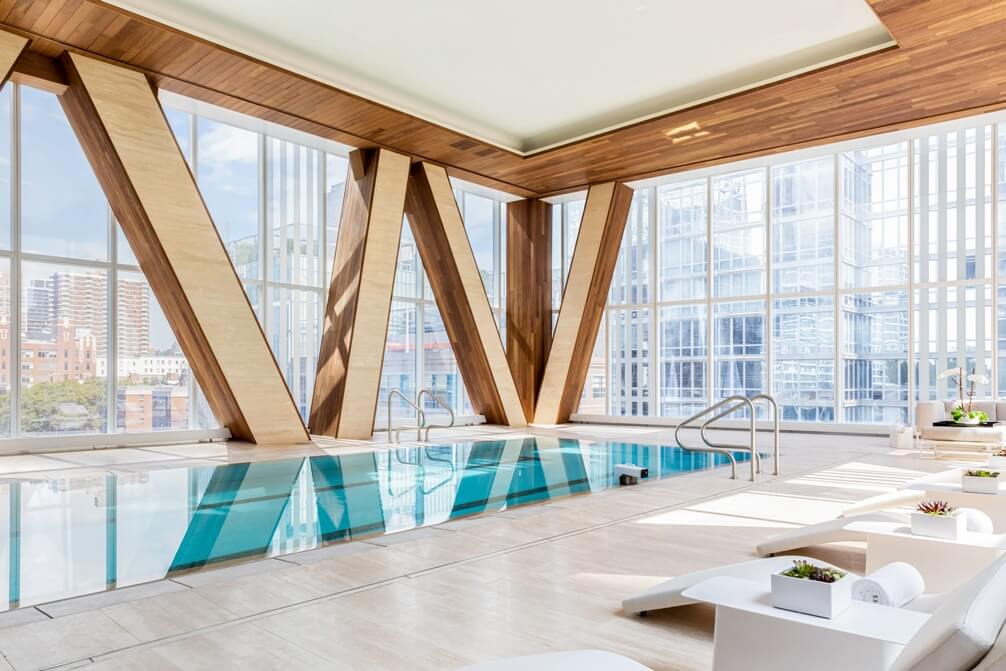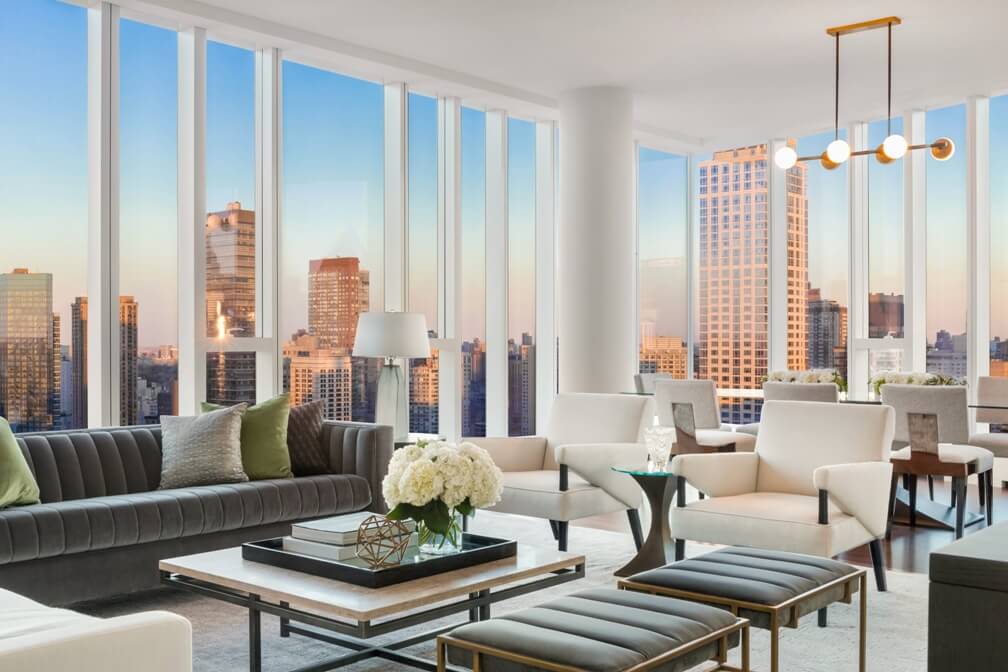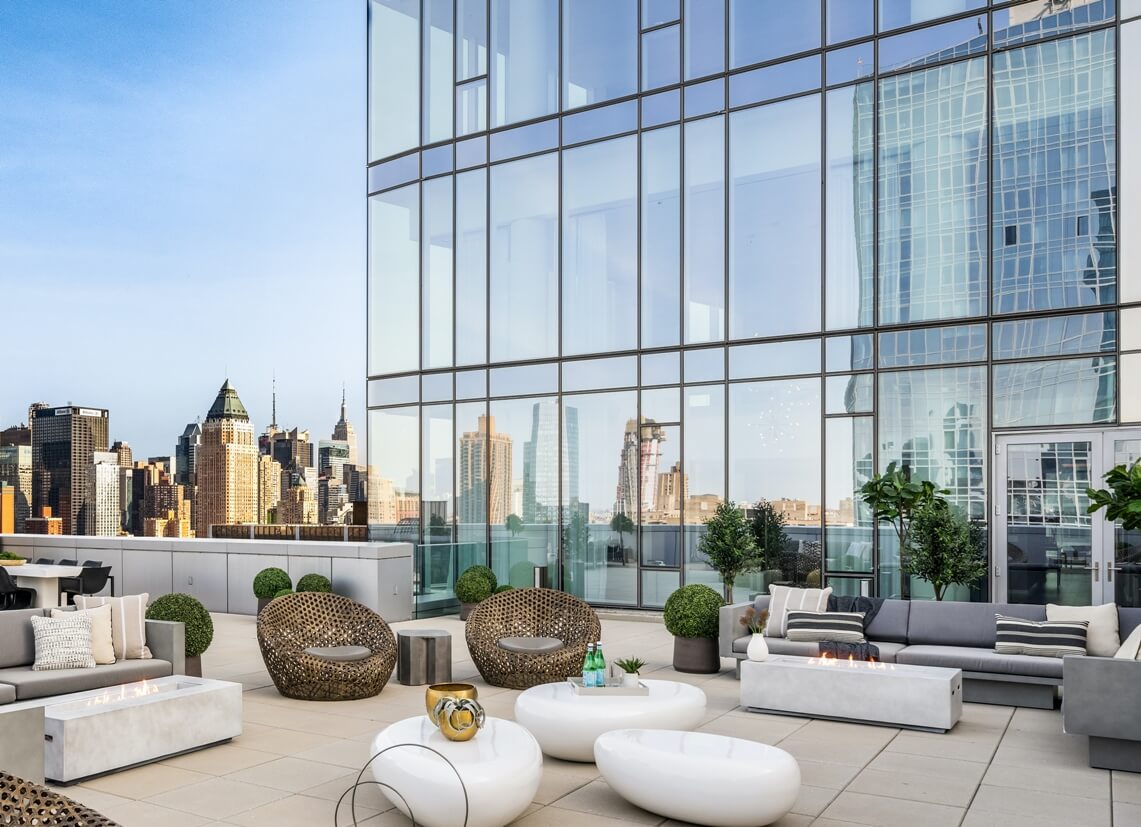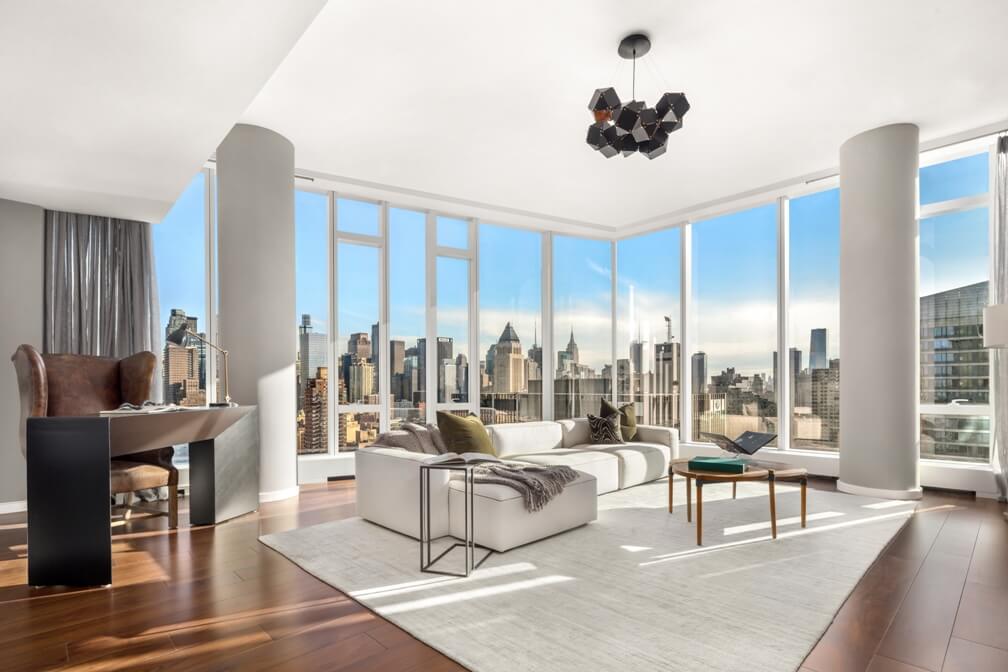
August 1, 2019
NYC’s amenity battleground
Developers are throwing more and more money at a growing class of employees who are providing everything from private tutoring to meditation, but some say doing so could actually turn off buyersSeated at a long dining table in a staged $11.8 million apartment on the 65th floor of 35 Hudson Yards, Mensur Cekic looks out the windows and surveys his territory.
Cekic, 39, is the “director of residences” for the Related Companies’ massive $25 billion Hudson Yards development — a vague title that masks the scope of his role. He is responsible for the needs of every resident across Related’s condo and rental buildings in and around the 28-acre site, including 15 and 35 Hudson Yards and the Abington House, which sits just outside the megaproject in Chelsea.
As of July, 60 percent of the condos at 15 Hudson Yards were under contract for a total of just under $1 billion. Meanwhile, sales at 35 Hudson Yards — where Related’s Stephen Ross is reportedly planning on living — are just beginning, with condos ranging from $5 million to $28 million, plus yet-to-be-priced penthouses.
As the person in charge of tending to the needs of everyone living in one of those units, Cekic fills a unique role: a concierge to top all concierges.
“Hundreds of years ago you had the innkeeper … who made your bed, who served your dinner, who took care of you,” he told The Real Deal. “I think it’s a bit of a return to that.”
While fitness centers and concierges have long been mandatory for luxury condo buildings in New York, more developers are now expanding in-house services, providing buyers and renters with everything from pet care to private tutoring to urban farming.
Although there are no databases tracking these numbers, anecdotally it’s clear that Cekic is part of a growing class of employees making their careers catering to the needs of New York’s wealthy — and helping developers differentiate luxury condos from competitors in a market that’s seeing swollen levels of inventory.
New York City developers across the spectrum — from Related to Silverstein Properties to Simon Baron — are throwing millions of dollars at this army of workers and the services they’re providing. Some are employed full-time by developers; others are tapped as outside consultants and contractors.
Donna Olshan, president of Olshan Realty, which tracks $4 million-plus Manhattan residential sales, said this increase in services and staff is tied to the soft market.
“There’s this arms race in amenities and services to try and woo the buyer, because the market itself is losing speed,” she said.
“This is the latest wave of trying to dig your heels in and trying to fight your way through a tough market,” she added. “When the market heads south, there are more gimmicks.”
Michael Graves, a broker with Compass who specializes in luxury new development, said the underlying financials for these new developments have reached a point that was “not thinkable 10 years ago.”
But he said there’s a risk that the new amenities won’t attract buyers — or even worse, that the
increased common charges associated with these new services could end up deterring sales.

“There’s a danger in some of these amenities,” said Graves. “You don’t want to do something that’s going to be seen as un-useful and financially cumbersome.”
Concierge-in-chief
The trend toward five-star services began in the mid-aughts at 15 Central Park West and the Plaza.
But those services can look quaint compared to what’s being rolled out these days.
Cekic, who oversees a team of more than 25 employees, was hired by Related to head concierge services at Hudson Yards in 2018 after years of working at luxury New York hotels, including the Mandarin Oriental, the Ritz-Carlton and the Baccarat.
The Montenegro native moved to New York when he was 12 and got his start at the Mandarin as a concierge while studying political science and international law at Seton Hall University.
While Related declined to say how much it spends on staff and services, the salary for a high-end concierge in New York City can range from $70,000 to $120,000, according to job site ZipRecruiter —though industry insiders say developers likely pay more for management positions.
Cekic said he uses his hospitality industry training every day. “I treat my residents as five-star hotel guests who never check out,” he said. “Luxury is getting it done before the resident has to ask.”
That includes everything from checking on dry cleaning to booking helicopter rides to the Hamptons to making sure a resident’s flat tire is changed in the middle of the night.
Cekic arranged for Hudson Yards residents to be the first to walk on the Vessel, the Thomas Heatherwick-designed sculpture at Hudson Yards, and to visit Snark Park, the nearby exhibition space, before either opened to the public. He also partnered with Equinox Fitness, which Related owns, to arrange running sessions up and down the Vessel for residents.
And he helps with more everyday requests, like getting tickets to Broadway shows and dinner reservations at exclusive restaurants.
“Never say no,” he tells his staff. “If something’s not possible, if it’s not moral, or ethical or legal, offer something else, offer an alternative.”
Cekic is not the only concierge-in-chief type on the New York City luxury condo scene. With prices at the upper end of the luxury market reaching new heights — read: Ken Griffin’s $238 million purchase at 220 Central Park South and Jeff Bezos’ $80 million purchase at 212 Fifth Avenue, not to mention 10-plus sales of $30 million or more at 520 Park Avenue — such staffers are now expected. At 432 Park, similar services are provided by head concierge Bill Todt.
“The services being provided cover every single need,” said Winston Chesterfield, founder of London-based Barton, a consultancy that works in the luxury sector across several industries, including real estate. “It’s like a teenager being taken care of by their parents.”
And if the service isn’t up to scratch, buyers can easily take their business elsewhere.
“They can start to feel: ‘This isn’t high-end enough for me, I could just have my own staff doing this,’” said Chesterfield. “So these buildings keep offering more and more things these people want.”
Compass’ Graves said, however, that developers are caught in a constant balancing act: looking for the right new amenity while trying not to overspend on something that won’t appeal to the market.
“At some point, there’s a diminishing return if you’re selling to the highest echelons of people in the market,” said Graves. “If you’re flying private, and you own six homes and you have a private chef, then you also have someone who works as your personal concierge service.”
Kids’ concierge
A typical day for Rachel Lerch can involve setting up a pretend tea party in her corner office on the seventh floor of One West End — Elad Group and Silverstein Properties’ Upper West Side tower.
She’s used to the scuff marks on her office floor from Razor scooters and the impromptu puppet shows from the building’s youngest residents.
The 42-story tower — which opened in 2017 with 246 luxury condos and 116 affordable rentals — has all of the standard New York City amenities, including a landscaped rooftop, a fitness center, a pool, billiards and media rooms and a chef’s kitchen for private events.
But the 30-year-old Lerch, who was hired as One West End’s lifestyle director in 2017 and previously worked at the private concierge company LIVunLtd, also runs a kids’ concierge service at the tower, where sponsor listings currently range from about $5 million to $19.5 million
“We found that there are so many families that we should really focus on taking some pressure off,” said Lerch, who noted that services are free to residents. “We’re there to help the kids with anything they need.”
To date, that’s included everything from planning a Dr. Seuss-themed birthday party to organizing playdates, swim lessons and language classes. Lerch also instituted a parents’ committee that meets monthly and consults on decisions like which books and toys to purchase.
Amenities aimed at children have, of course, exploded over the last decade. But these days, it’s not just playrooms.
At Lightstone’s 244-unit 130 William in Lower Manhattan, there’s a mini soccer field and a mini basketball court as well as a trampoline room. And at HFZ Capital Group’s luxury condo the Chatsworth on West 72nd Street, the developer has partnered with the Brooklyn Robot Foundry to offer classes where parents and children can build robots together.
Developers are also hiring tutors and other academic specialists to lure in families with older children.
“If you’re going to invest $3 million or $4 million in an apartment, you want to make sure you cover all the bases,” said Amanda Uhry, a private-school consultant who works with New York developers. “They say it’s harder to get into private school in New York than Ivy League schools.”
Uhry — who heads up a company called Manhattan Private School Advisors — is currently consulting at Simon Baron Development’s Upper West Side condo project the Chamberlain, among other developments.
Wealthy buyers, particularly international buyers, often want help navigating the New York City private school landscape, she said.
Part of the problem, Uhry said, is that there are not enough private schools in Manhattan, and parents are still attracted to the older and more prestigious ones, like the Dalton School, the Collegiate School or Trinity School. “If you apply to 12 and get into three — that’s a success,” she said.
Uhry said she’s traveled to Tokyo and Seoul to advise high-end New York condo buyers on how to navigate the admissions system when they arrive in New York.
Uhry is part of the broader world of consultants and tutors who in the past were hired largely by wealthy families but are increasingly landing business from developers.
“Everybody has the basics now. Everybody has a screening room. Everybody has a gym,” said Michael Fazio, LIVunLtd co-founder and chief creative officer. “It’s all about the ‘what else?’”

Leya Ogihara, the founder of Dog City
“Pee and play”
Outside the Caledonia on West 17th Street in Chelsea, Leya Ogihara stretched out her arms to greet a large, white Bernese mountain dog. “Cornelius!” she bellowed.
Ogihara, 47, is the founder of Dog City — the amenity developed by Related to provide pet-care services in its luxury Manhattan buildings.
The first Dog City opened at the developer’s MiMA tower in Hell’s Kitchen in 2011, but there are now five at Related buildings citywide providing day care, training, grooming, boarding and veterinary services for residents’ dogs.
While the trend is not new, developers are doubling down on this space as well.
Pet care company Throw Me a Bone is used by several luxury buildings, including Extell Development’s 555Ten on 10th Avenue in the Hudson Yards neighborhood, Brookfield Property Group’s nearby rental tower the Eugene, TF Cornerstone’s 33 Bond and Taconic Investment Partners’s 525W52. Meanwhile, Extell’s One Manhattan Square on Cherry Street in Lower Manhattan includes a covered dog run and private grooming services.
Ogihara — who is originally from Yokohama, Japan, where she grew up surrounded by goats, chickens and dogs — came to the U.S. when she was 19 and started working in dog rehabilitation. Now she is usually accompanied by three large St. Bernards named Hamso, Masato and Yamato, her “helper” dogs.
Ogihara, who oversees a team of 17 staff members, has run Dog City for nearly a decade. As part of Dog City’s “pee and play” services, dogs are picked up at their owner’s apartment, spend two to four hours walking outside and learning good behavior and then get dropped off at home. “The owner comes home to a nice, content, tired dog,” Ogihara said.
Residents in Related’s building can set up customizable Dog City packages. A spokesperson for the company said some residents spend up to $750 a month on Dog City services.
Ogihara said she’s extremely selective when it comes to hiring staff. “They have to be the type of people who really give a damn,” she said. “We have to be advocates for the dogs.”

Ellie Burrows Gluck, co-founder of a network of meditation studios
Breath, heart, intention and sleep
“If you think about where yoga was 30 years ago, that’s where meditation is now,” said Ellie Burrows Gluck, co-founder and CEO of MNDFL, a network of drop-in meditation studios with Greenwich Village, Upper East Side and Williamsburg locations.
But whether it will move in the same direction yoga did could, ironically, be decided by its ties to multimillion-dollar real estate.
Gluck’s company is now partnering with Chetrit Group, Clipper Equity and Read Property Group to open a residents-only studio at theirTower at Gramercy Square, a 223-unit condo, which has a projected sellout of $817.5 million, according to the offering plan.
Closings have started at the building, where the most expensive unit is listed for $11.2 million. Other amenities include a spa, a 75-foot pool, a wine cellar, a golf simulator and an outdoor lounge.
But residents will also get two free guided meditations a month with themes like “breath,” “heart,” “intention” and “sleep,” said Gluck, whose partnership with Chetrit, Clipper and Read is her first with New York developers.
Meditation is not the only Asian-influenced service being offered in luxury developments. Feng shui-centered design and marketing are also becoming increasingly mainstream.
“People take it very seriously,” Olshan said. “If you use the principles when you build, it’s good. Many Asian buyers look at feng shui.”
At the Park Loggia at 15 West 61st Street, AvalonBay Communities brought in feng shui master Debra Duneier, founder of design consultancy EcoChi, to help choose artwork and sculptures for the property’s shared areas. She suggested replacing the sculpture in the building’s porte-cochère with one that resembles the leaves of a jade plant, considered auspicious in feng shui, and includes a water feature. “[The water] symbolizes prosperity and abundance, which means a good life,” she said, noting that it’s the first thing a potential buyer will see.
Duneier — who is also on her first partnership with a Manhattan developer — uses compass readings to determine the direction each room faces, which determines the “energies that come with that direction” and the elements associated with those energies, like wood, water or fire.
If the energies don’t match the room’s intended purpose, she chooses art to optimize the energy.
“Will they sell it? I don’t know if they’ll sell,” said Olshan, referring to the use of feng shui. “But at least the people will come through the door.
Risk vs. reward
For developers, having all of these services and staffers comes down to selling units — which has gotten increasingly harder in this uncertain economic environment.
But overdoing amenities, choosing the wrong one or gearing them to one specific group are all financial land mines.
Just a few years ago, for example, Chinese buyers were flooding the New York market. But Chinese investment in New York has been contracting since the Chinese government instituted capital controls and limited overseas investment.
LIVunLtd’s Fazio said, however, that developers are increasingly open to offbeat ideas. His firm has been in talks with some New York developers about cryo-chambers (cold-therapy rooms) and ice fountains in their projects.
“Years ago, they would have said: ‘You’re a freak, get out of my office,’” he said. “They’re open to it all now.”
He argued that developers can offset the financial risk of going too niche by continuing to provide basic amenities. “They will still have the yoga room,” he said. “They will still have the screening room. The recording studio won’t replace it.”
But Compass’ Graves had a different take, saying that buyers, particularly at lower price points, may be turned off by the higher common charges associated with increased amenities and services.
“That’s something that on every buyer’s mind,” Graves said. “They think: ‘I don’t even want that amenity, so why am I paying for it?’”
View Original Article: https://therealdeal.com/issues_articles/nycs-amenity-battleground/




